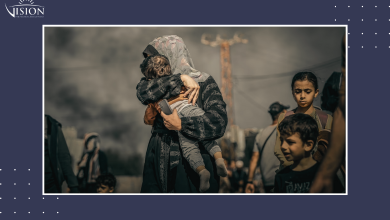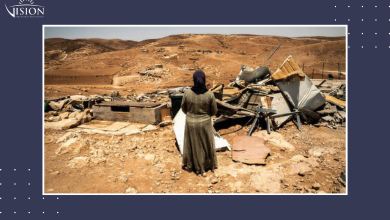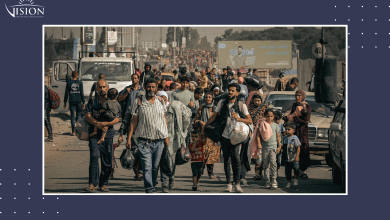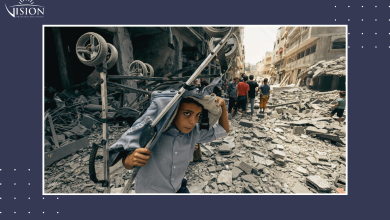Is Israel ‘(Re)engineering’ the geopolitical reality in the West Bank?

Suleiman Bisharat[1]
On January 21, 2025, the Israeli occupation announced the start of a military operation named “Iron Wall” in the city of Jenin and its refugee camp, with the participation of Israel Defense Forces army and the Shin Bet units, with the aim of eliminating the Palestinian resistance. The operation quickly expanded and developed to include Tulkarem Camp, then Al-Far’a Camp and the town of Tammun in the Tubas Governorate, and later extended to Nur Shams Camp in Tulkarem. Simultaneously, the occupation intensified its practices of raids and destruction of infrastructure in several Palestinian towns and cities, most of which were concentrated in the northern West Bank.
In its military operation, the occupation did not limit itself to the conventional methods of raids, arrests and assassinations, but also resorted to the systematic demolition of infrastructure and homes. Streets were even carved through the refugee camps of Jenin, Tulkarem, and Nur Shams, and entire residential blocks were demolished after residents were forced to evacuate.
This destructive military action on the ground was accompanied by a series of Israeli positions, statements, and decisions that included the official adoption of the term “Judea and Samaria” as a replacement for “the West Bank,” and a declaration by the Defense Minister about pursuing “long-term control” over the camps. The occupation culminated these moves practically through a visit by Israeli Prime Minister Benjamin Netanyahu and his Defense Minister to Tulkarem Camp.
The pattern of Israeli behaviour during the military operation and in its political positions was marked by gradual escalation and expansion—both geographically and in terms of methods, tools, and mechanisms used. However, the most prominent feature was the specific targeting of refugee camps, indicating that Palestinian refugee camps were the primary focus of this campaign. This suggests that the operation goes beyond the Israeli narrative of it being merely a security-military campaign in the northern West Bank. It points to broader objectives and a new reality that the Israeli occupation is attempting to impose in the West Bank.
The central question now strongly being raised is: Is this operation the beginning of a new political phase that the occupation seeks to establish in the West Bank? What would this phase look like? And what are its potential implications for the Palestinians in terms of politics and daily life?
Details of Ongoing Operations
From the very first day of the military operation in Jenin and its refugee camp, the Israeli occupation carried out mass assassinations using military and drone strikes, along with sniper attacks and direct killings, resulting in the martyrdom of nearly 25 Palestinians over the course of a month of ongoing operations. Simultaneously, it deployed a large military force consisting of armoured vehicles, Namer armoured personnel carriers, D10 bulldozers, and wheeled bulldozers. The occupation imposed a tight siege on the camp and the surrounding hospitals—including Ibn Sina Hospital and Jenin Government Hospital—while broadcasting evacuation orders, giving residents a limited time to begin leaving the camp before Israeli bulldozers started demolishing several homes.
For the first time, the occupation resorted to forcibly displacing residents under threat. The time limit it set for families to evacuate their homes felt like a nightmare, pushing more than 20,000 camp residents to flee in search of shelter. With the camp nearly emptied, the occupation began systematically demolishing neighbourhoods and homes in a coordinated manner. Bulldozers began carving new roads and dividing the camp into blocks and districts to facilitate control, encirclement, and complete isolation from the rest of the city and its neighbourhoods. It was as if the occupation was attempting to implement a kind of re-engineering of the area in line with its broader plans.
The occupation began implementing the same strategy and methods in Al-Far’a Camp and the town of Tammun, where their incursions lasted for over a week before the forces withdrew, leaving behind significant destruction to infrastructure, demolishing many homes, and setting fire to several others.
Also, a scenario identical to what is happening in Jenin is being fully carried out in the Nur Shams and Tulkarem camps. The military operation in both has been ongoing for more than a month, and the occupation continues working to alter their geographic structure—using the same methods as applied in Jenin Camp; the forced displacement of thousands of residents, the systematic demolition of homes, and the carving of roads within the camps.
Gradual Change and Expansion of Targets
It may be noted that the military operations in the northern West Bank were not initiated at this particular moment in time. The Israeli occupation has been implementing gradual and sequential expansionist policies over many years. The features of these policies have become increasingly clear, with their pace, methods, and forms accelerating—transitioning from a phase of preparation to one of execution and consolidation.Since 2021, the Israeli occupation government launched a systematic and ongoing process to weaken the economic situation in the West Bank through the piracy of clearance funds, depriving government employees from receiving a full salary. These actions were justified by fabricated pretexts, such as the Palestinian Authority’s payment of stipends to the families of prisoners and martyrs, and by linking the transfer of clearance funds (maqassa funds) to political positions. Over time, this has become a sustained policy, with all attempts to pressure the Israeli side into halting the piracy proving unsuccessful.
In parallel, the occupation began implementing plans to intensify settlement activity on the ground. In December 2024, the newspaper Israel Hayom revealed a plan to establish four massive new settlement cities, each designated for specific population groups—one for the Druze community, another for ultra-Orthodox Jews, in addition to the expansion of existing settlements to transform them into cities with new infrastructure frameworks.
According to a report by the Israeli left-wing organization Peace Now, 43 new settlement outposts were established during 2024. This is a sharp increase compared to the historical average of no more than 7 outposts per year since 1996.
Also in December 2024, Israeli Finance Minister Bezalel Smotrich announced a series of measures aimed at annexing 60% of the West Bank, beginning with the imposition of Israeli sovereignty over settlements and progressing toward the full annexation of the territory.
Implications of Israeli Expansionist Practices
The occupation’s deliberate strategy of gradually escalating and expanding its incursions in the West Bank appears to be part of a cumulative preparatory process aimed at reaching a turning point—one that could transform the nature of the relationship between the occupation and the Palestinian reality in the West Bank. This can be interpreted through the nature of the ongoing military operation in the northern refugee camps, which seems to serve as a culmination and a turning point—laying the groundwork for a new phase of control over the West Bank, in line with the Israeli occupation’s revised vision.
After having tightened its stronghold on all aspects of the Palestinian situation—particularly the economic one—and following signs of economic recovery in the West Bank tied directly to the Israeli economy, the occupation began implementing a systematic reduction process. This triggered a series of economic shocks, bringing the Palestinian market to the brink of total paralysis. This has been carried out by controlling clearance funds (maqassa), border crossings, and imports. Additionally, since the start of the war on Gaza, more than 150,000 Palestinian workers have become unemployed.
This raises the question: What goal is the occupation seeking to achieve through all these practices in the West Bank? To answer this, we can approach the issue from multiple angles:
First: Re-engineering the Geography of the West Bank
The continued geographic cohesion of the West Bank represents a failure of the expansionist settlement vision. In order to realize its settlement expansion goals, the Israeli occupation has, over the past decade, intensified land confiscation efforts and fragmented the territorial continuity between cities and governorates. This culminated in the establishment of around 900 gates and checkpoints at the entrances of Palestinian villages, towns, and cities.
The occupation has also exploited the war on Gaza to promote a narrative suggesting that the West Bank could face a scenario similar to October 7, as occurred in Gaza. Under this security pretext, the Palestinian geography has been transformed into isolated enclaves where movement can be tightly controlled. Meanwhile, geographic continuity has been enabled and strengthened between Israeli settlement blocs, heavily supported by an infrastructure network the occupation has been developing for many years.
Following this, the occupation launched a military operation focused on the refugee camps in the northern West Bank, specifically in the cities of Jenin and Tulkarem. This appears to be part of a broader strategy to reconstruct the geography—even from a security perspective—and perhaps to create a geographic model that could be expanded and gradually applied more broadly in the future.
Second: Psychological Re-engineering of the Social Base in the West Bank
Over the past years, the occupation has worked to reshape the concepts of solidarity, popular mobilization, and resistance to its practices. This effort intensified after the war on Gaza, as the occupation began presenting a threatening model—implying that the destruction, killing, and genocide experienced in Gaza could be replicated in the West Bank.
In addition to carrying out arrests, assassinations, and infrastructure destruction, the occupation aimed to instill a psychological state of fear and deterrence. At a certain point, this model even began to manifest as a kind of internal Palestinian narrative justifying silence or acceptance of the current reality—driven by fear of potential Israeli retaliation in the West Bank.
This culminated in the current military operation, destruction, and displacement taking place in the Jenin and Tulkarem camps, with the occupation succeeding in isolating these camps from broader popular support and their surrounding communities in the West Bank. This message was directly conveyed by Israeli officers during a meeting at the Jenin Chamber of Commerce, where they proposed a return to normal life and framed what is happening in the camps as something “routine” that Palestinians should adapt to.
Third: Demographic (Population) Engineering
In its military operation in the northern West Bank, the Israeli occupation has adopted a method of population displacement through the forced eviction of residents from refugee camps and areas where military operations are conducted. According to a report by the United Nations Relief and Works Agency for Palestine Refugees (UNRWA), nearly 40,000 Palestinians from the camps of Jenin, Tulkarem, and Nur Shams have been displaced from their homes and are now residing in temporary shelters.
This represents a continuation of the same methodology the occupation has pursued over the past year—a form of silent forced displacement. Numerous reports have documented the displacement of 67 Bedouin communities in the West Bank during 2024, further reflecting this ongoing policy of demographic manipulation.
Fourth: Political Re-engineering of the West Bank
A striking feature of the Israeli occupation’s military operation has been the statements made by Israeli Defense Minister Yoav Gallant during a raid into Jenin Camp, where he declared: “Jenin Camp will not return to how it was before,” and that the Israeli army “will remain in the camp.” Similarly, Israeli Prime Minister Benjamin Netanyahu and Defense Minister Gallant stormed the Tulkarem Camp, releasing images of a meeting held inside one of the camp’s homes and speaking of the beginning of a new phase.
This indicates that Israel is now solidifying a new stage involving the erosion of Palestinian sovereignty, in favour of direct Israeli military control. It could signal the implementation of a policy of permanent military presence in specific areas of the West Bank—paving the way for a gradual expansion of control and ultimately reaching a point where Israel may formally declare sovereignty over parts of the territory, in line with what is known as the annexation plan.
Additionally, the occupation’s efforts to re-engineer the refugee camps may also represent the beginning of a broader strategy to dismantle UNRWA, the UN Agency for Palestinian Refugees—potentially eliminating the right of return from any future political negotiations.
Conclusion:
The Israeli occupation’s military operations in the West Bank cannot be understood separately from its broader political vision for the future. It is clear that this is a preparatory phase for what may later be officially announced—either a reassertion of Israeli military control over the West Bank without labelling it as “occupation,” thus freeing Israel from any responsibilities toward managing the Palestinian situation, or possibly an attempt to pave the way for a political deal with a future Trump administration, involving formal recognition of the annexation of the West Bank or parts of it.
In such a scenario, the concept of a Palestinian entity would be stripped of political sovereignty, reduced instead to a service-oriented administrative presence—a collection of local administrations within isolated enclaves or cantons. These would remain under the full control of the occupation, subject to its motivations and strategic interests.
[1] Researcher at Yaboos Foundation for Consulting & Strategic Studies. http://yabous.info/





